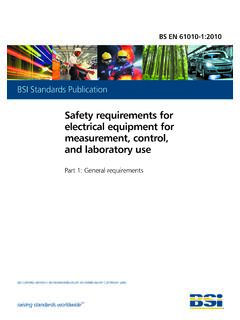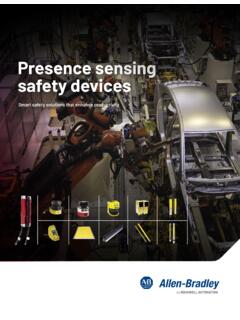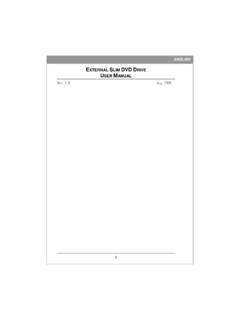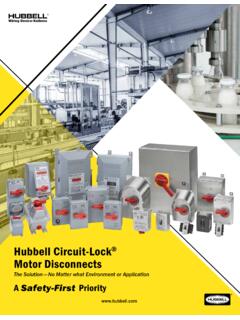Transcription of A GUIDE TO PLASTIC ROTATIONAL MOLDING
1 A GUIDE TO. PLASTIC ROTATIONAL MOLDING . IN THIS GUIDE , WE WILL COVER: Overview of PLASTIC ROTATIONAL MOLDING Advantages of RotoMolding PLASTIC MOLDING Process Comparison The Rational MOLDING Process Critical Design Considerations for Rotationally Molded Parts The Nominal Wall the Frame of your Product Uniform Wall Thickness Non-uniform Wall Thickness Flat Surface Limitations Parallel wall separation Requirements for corner angles Draft angles for easy removal Designs using internal and external undercuts ROTATIONAL MOLDING Tooling Fabricated Molds Cast Aluminum Molds CNC Molds Epoxy Molds Mold-in-Graphic Options Typical Projects Sterling Technologies | 10047 Keystone Drive Lake City, PA 16423 | | A ROTATIONAL . MOLDING OVERVIEW. ROTATIONAL MOLDING is a unique PLASTIC MOLDING process used to produce large hollow parts. Often referred to as rotomolding, because the molds are slowly rotated in an oven spreading the resin inside using centrifugal force to fill the walls of the mold.
2 Depending on the purpose of part, wall and corner thickness can vary to suit that requirement. This is critical for water and air tight containers and tanks. ROTATIONAL MOLDING is a versatile manufacturing option with many benefits over standard thermoform, injection and blow MOLDING . This process makes it possible to design very large hollow pieces in virtually any shape, size, color and configuration. Generally, pieces are lightweight with strong structural integrity. The process uses a variety of mold types and MOLDING machines that contain loading, heating and cooling areas. Once a mold is bolted to one of the machine's rotating arms, the pre-measured PLASTIC resin is loaded. Several molds on as many as three arms can be used at the same time. The molds then move into the oven and rotate on both the vertical and horizontal axis.
3 The melting resin adheres to the mold and lays down a thick even coating, filling in areas that need more structure. The rotating continues during the cooling cycle where the part retains an even thickness. Sterling Technologies | 10047 Keystone Drive Lake City, PA 16423 | | PLASTIC MOLDING Process Comparison Lost Foam MOLDING Reaction Vacuum Forming Twin Sheet Selective Lazer Rapid Injection Blow Compression Extrusion ROTATIONAL Thermoforming Casting Process Injection (vacuumforming) Foaming Sintering Prototyping (for making molds). A parison PLASTIC charge is Method of PLASTIC material is Part is coated and PLASTIC is injected (tubular PLASTIC Heated PLASTIC sheet Heated PLASTIC Heated PLASTIC is Heated PLASTIC is placed in mold Heated PLASTIC sheet Thermoforming that heated with a laser Photosensitive pressed into sand. Process into mold charge) is is stretched over charge is injected forced through a die which rotates, is stretched welds 2 PLASTIC sheets until its particles PLASTIC is cured by a Metal (or other Description into mold and cures from attached to a mold and suctioned compressed to creating a long part bi-directionally, over mold into adhere to laser in layers material) is poured chemical reactions mold and then into the form shape of the mold in oven one 3D product each other into depression filled with air Disposable cups, Pallets, portable Containers, containers, lids, trays, toilets, housings, Product packaging, Automotive parts, fuel cells, blisters, clamshells, tanks, air &.
4 Creating small Panels, Enclosures, Concept or highly Making molds and Ideal Bottles, various speaker casings, textiles, large Tubing, piping, Large/complex vehicle door and ventilation ducts, and/or critical housings, specific/critical Concept designs duplicates of Purposes tolerance parts automotive parts containers car dashboards, pattern pieces fiber optics products, housing, dash panels, enclosures, cases, tolerance designs concept designs aerospace enclosures, refrigerator liners, toys, flat and concept products utility vehicle beds, transportation . and pallets related products Low Mold Cost? X X X X X X N/A N/A N/A. Low Unit Cost? X X X X X. Quick Turn Around Time? X X X X X. High Strength Parts? X X X X X. Complex Part Geometries? X X X X X. Very strong, Can mold large and Useful for Great for making flexible, cheap parts.
5 Quick turn intricate patterns, extremely critical Excellent for molds and rarely Low mold costs, Fast, cheap Flexibility in Low cost and quick Several finishing and Strong and Stiff, more Pros around and very strong flexible parts production MOLDING structures very low cost, Ultra turn around production options. flexible parts structural parts dimensioned scaled down duplicates of parts detailed parts large basic shape designs, no concept models our of specific Complex geometries production mold costs metal materials are possible. Weaker parts Only adept at making Limited geomtry, Very small tolerances Slower processing Very expensive, than other Long process times, shallow parts, Poor product additional machines Very high costs, Not useful Weaker parts, VERY limited are difficult to form, and very difficult fragile, cannot be Cons processes, expensive raw limited geometry Processing consistency, heavy geometry slower than high- to form complex req'd for various slow process, easily modified, for production Very high material costs can be difficult, flash issues materials, parts size limitations and expensive speed processes geometries Size Restrictions upfront costs limited geometry aren't as flexible Sterling Technologies | 10047 Keystone Drive Lake City, PA 16423 | | ADVANTAGES OF.
6 ROTATIONAL MOLDING . Parts originally assembled from several pieces can be molded as one piece. Manufacturers can produce consistent, stress-free wall thickness and strong outside corners. Engineers can select the best materials and additives for their application making the parts weather resistant, flame retardant, or static free. Designers have the option of adding inserts, threads, handles, minor cuts and fine surface detail. Large and small parts can easily be produced. Since there is no internal core, minor changes can be made to existing molds making the process more cost effective. Parts are formed with heat and rotation, unlike injection MOLDING , which requires high pressure. Material and production costs are lower because lightweight materials replace heavier and often more expensive materials. Manufacturers can get their product through prototyping and to market quickly.
7 Sterling Technologies | 10047 Keystone Drive Lake City, PA 16423 | | ROTATIONAL . MOLDING PROCESS. The ROTATIONAL MOLDING process uses biaxial rotation and high temperature to fill the mold and form the PLASTIC part or component. The rotomolding process is ideal to produce large, hollow, one-piece parts. Sterling Tech operates Carousel type ROTATIONAL MOLDING machines with at least 3 arms with multiple molds positioned on each. In its simplest form, one arm is being loaded and unloaded, one arm is rotating or spinning in a gas-fired oven MOLDING the parts, and the third arm is being air or water cooled. Each arm may contain 2,4,7 up to 10 separate molds per process cycle. The rotomolding machine's arms move independently from one another allowing a variety of mold sizes with different receipts for heating and thickness. Each part being molded has its own recipe for production.
8 This includes the amount and formulation of the resin, rotation speed, oven temperature and processing or heating time. Cycle times can be often up to 30 minutes. With these longer cycle times, rotationally molded parts typically have run lengths ranging from just a couple to hundreds of parts with annual order quantities as low as 50 up to thousands of parts. Ensuring proper product design is critical for manufacturing and assembly optimization as well as the general success of the product itself. ROTATIONAL MOLDING designs and prototypes using 3D solid model rendering and rotolog tooling capability studies are used to help GUIDE customers through the intricacies of the ROTATIONAL MOLDING process. Sterling Technologies | 10047 Keystone Drive Lake City, PA 16423 | | With pending ISO 9002 certification and drawing from techniques outlined in Six Sigma, World Class and Lean Manufacturing, Sterling Technologies is dedicated to delivering superior quality.
9 Process controls include rotolog tooling capability studies to optimize product quality throughout the run. Click Here to watch ROTATIONAL MOLDING Video Sterling Technologies | 10047 Keystone Drive Lake City, PA 16423 | | DESIGNING A SOUND. ROTATIONALLY MOLDED. COMPONENT. THE NOMINAL THE FRAME OF YOUR PRODUCT. The nominal wall is the basic frame of your product. It is the single most important aspect of your design and it must be handled correctly for quality assurance. The thickness of the nominal wall will not only determine its strength, but also its load bearing capability. The thickness will have a direct effect on the cost of your overall product. The ideal minimum thickness of .125 inches provides a good compromise between cycle time, processing ease, strength of product, and cost. The ROTATIONAL MOLDING process permits a designer to change the wall thickness of their product after the mold has been built, tested and sampled.
10 This versatility is not common in other PLASTIC processing techniques. Sterling Technologies | 10047 Keystone Drive Lake City, PA 16423 | | UNIFORM WALL THICKNESS. The general nature of ROTATIONAL MOLDING allows the thickness of the wall to be even throughout the finished part. This gives designers more flexibility with product design, even with the most unusual shapes. Although designers have gone as low as .090-inch wall thickness, a safe .125-inch minimum should be adhered to. NON-UNIFORM WALL THICKNESS. Although ROTATIONAL MOLDING is known for its uniform wall thickness, non-uniform wall thickness can also be produced with some limitations. Several techniques are used successfully to produce items like vertical storage tanks with gradually thickening wall near the bottom where the weight limit is greater. Sterling Technologies | 10047 Keystone Drive Lake City, PA 16423 | | FLAT SURFACE LIMITATIONS.




